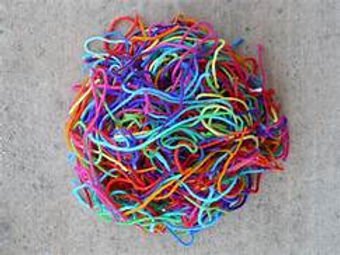#99: Untangling Yarn.
Lessons for getting your house in order.
Untangling yarn. Have you ever tried to untangle a wad of yarn made up of several unraveled skeins?
The process is instructive.
Let’s choose one thread/color to represent our proverbial house (or business) and the act of freeing it represents our goal of creating order therein.
The first step in the process is to recognize that there are intertwined forces creating disorder (e.g., clutter, chaos, confusion) in our midst. And we should begin an exploration of those threads by choosing one and following (observing) it until there is resistance. Then gently create space—part the threads away from each other as if parting branches to peek through a bush.
Space at the resistance.
Space is key. It means to bring keen awareness to our struggles—observe them consciously in the moment for a time instead of continuing in our usual state of reactive oblivion. We create space between ourselves and the situation as if we are watching a movie of our own lives.
We start to see the situation more clearly and then gain a better sense of which way to go next.
Which thread needs observation now? Which bond (relationship or belief or habit or emotion) needs to be released?
What is surprising is that the last color to be untangled is often the most tightly intertwined. The most resistant and insidious. The strongest force holding us back.
My guess is that this force is related to fear or belief.
When there are only two left to tango, there are no other threads to distract, to blame. Things are clear. There are only two ways to go—become more bound or step closer and closer toward our vision.
All of this comes down to taking responsibility for the direction of our lives. It is a process with work and difficult choices but the end result is satisfying.
#98: U-Turns.
One path goes from safe to boring.
U-turns. A knee jerk reaction says no and then there is a pause.
The pause gives time for consideration and an opportunity for wisdom to settle in.
An honest mulling of the question “why not?” turns around the answer to yes after compelling visions begin to surface of buoyant possibilities. Now, “no” feels confining—boring even.
This isn’t always the path so we lean on wisdom, which is quite the shepherd if given the chance.
#97: Ways of Communication.
Frames that illuminate.
Ways of communication. As an extended study on widening the frame, plants offer an illuminating case.
Spoken, written, musical, non-verbal.
Non-verbal communication is not foreign to humans. We rely on it heavily, in fact. Its powers make the case for keeping things IRL when it matters.
But even our frame for the concept of non-verbal communication is limited. Gestures, facial expressions, postures, and the hard-to-explain (intuition?).
If we expand the frame beyond counting on two hands the forms with which we are familiar, we might ask, “What combinations of energy and matter bind with intelligence to bring about communication?”
Plants live in community and, as such, have ingenious ways of communicating. Zoë Schlanger, author of the book The Light Eaters, explains one example.
“The primary way plants communicate with each other is through a language, so to speak, of chemical gasses. ... And there's little pores on plants that are microscopic. And under the microscope, they look like little fish lips. ... And they open to release these gasses. And those gasses contain information. So when a plant is being eaten or knocked over by an animal or hit by wind too hard, it will release an alarm call that other plants in the area can pick up on. And this alarm call can travel pretty long distances, and the plants that receive it will prime their immune systems and their defense systems to be ready for this invasion, for this group of chewing animals before they even arrive. So it's a way of saving themselves, and it makes evolutionary sense. If you're a plant, you don't want to be standing out in a field alone, so to speak. It's not good for reproductive fitness. It's not good for attracting pollinators. It's often in the interest of plants to warn their neighbors of attacks like this.”
Communication is facilitation and its means are as diverse as its needs.

